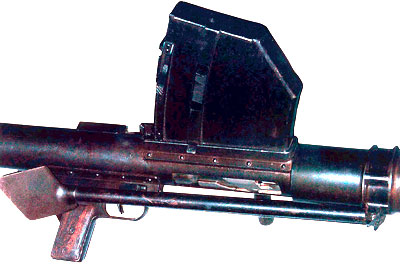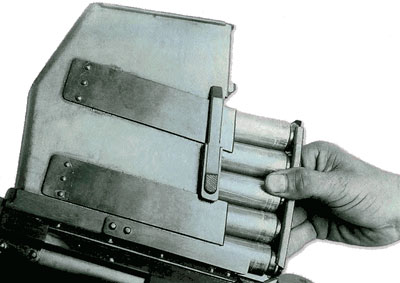Vladimirov anti-tank rifle

14.5 mm Vladimirov anti-tank rifle, model 1938
In the mid-1930s, the USSR began large-scale work on the development of anti-tank rifles. Among other developers, the famous Soviet designer S.V. took part in the competition for the new PTR. Vladimirov.
In August 1938, Vladimirov presented several versions of anti-tank rifles of 20 mm, 14.5 mm and 12.7 mm calibers at the Small Arms Scientific Testing Range (NIPSVO).
Vladimirov’s 20-mm anti-tank rifle had an automatic mechanism that worked on the principle of a long barrel stroke with a rotating bolt. The design and manufacturing simplicity of the weapon was noted, but it was rejected due to its heavy weight, unsatisfactory armor penetration, low maneuverability and lack of an open sight. The 20 mm gun had a weight of 42 kg, a total length of 2215 mm, a muzzle velocity of 831 m/s and a rate of fire of 9 rounds per minute.

View of the controls, magazine and folding bipod
of the Vladimirov 14.5 mm PTR
The 14.5-mm PTR had the same advantages, as well as a successful design of the magazine, into which, without separating it from the gun, a plate clip with cartridges was placed. When the cartridges were used up, the clip was thrown out of the magazine. The gun was equipped with an optical sight, made like a PE rifle sight, intended for shooting at remote and camouflaged targets, such as machine gun nests. The muzzle velocity was satisfactory, but the gun was rejected due to the low survivability of the barrel (150-200 shots) and unsatisfactory accuracy. The 14.5 mm gun had a weight of 23 kg, a total length of 2040 mm, a muzzle velocity of 1010 m/s and a rate of fire of 10 rounds per minute.
Vladimirov’s 12.7 mm gun had a similar design to the 14.5 mm model and had the same advantages and disadvantages. This sample had a weight of 23 kg, a total length of 2145 mm and an initial bullet speed of 1034 m/s.
Of all the guns tested in August 1938, the 14.5 mm caliber model was noted and recommended for modification to improve accuracy and increase barrel survivability.
In August 1939, a new sample of the 14.5 mm Vladimirov PTR was presented.

Loading 14.5 mm Vladimirov PTR
Vladimirov’s automatic PTR operated on the principle of barrel recoil with a long stroke (330 mm). Under the influence of recoil, the barrel, together with the rotating piston bolt, rolled back to the rear position, where the bolt rested on the sear, and the barrel, under the action of its spring, returned to its original position. At the same time, a spent cartridge case was removed from it, reflected downward. When the trigger was pressed, the bolt moved forward under the action of the return spring, removing the next cartridge from the magazine and sending it into the chamber of the barrel. In the forward position, the barrel bore was locked by turning the bolt cylinder and the cartridge primer was broken.
The gun had a permanent five-round magazine located obliquely on the right. The weapon was equipped with a clip of five cartridges, which were inserted into the magazine from the shooter’s side.
The mass of the Vladimirov model 1939 PTR was 22.3 kg with a total length of 2012 mm. It could be disassembled into two parts weighing 8.55 and 9.5 kg and could be carried by soldiers in any conditions. The rate of fire reached 15 rounds per minute. The initial bullet speed was 1030 m/s.
In August-September 1939, comparative tests of a new type of 14.5-mm anti-tank rifle by Vladimirov (TsKB-2) and Rukavishnikov (NIPSVO) took place. The results of firing from these anti-tank guns turned out to be approximately the same, and a significant number of malfunctions were discovered. The biggest problem was the delays associated with cases not being extracted.
Based on the test results, preference was given to the Rukavishnikov anti-tank rifle, which was adopted by the Red Army in 1939. Vladimirov’s anti-tank rifle was not accepted for service and did not enter mass production, remaining a prototype.

14.5 mm Vladimirov anti-tank rifle, model 1939